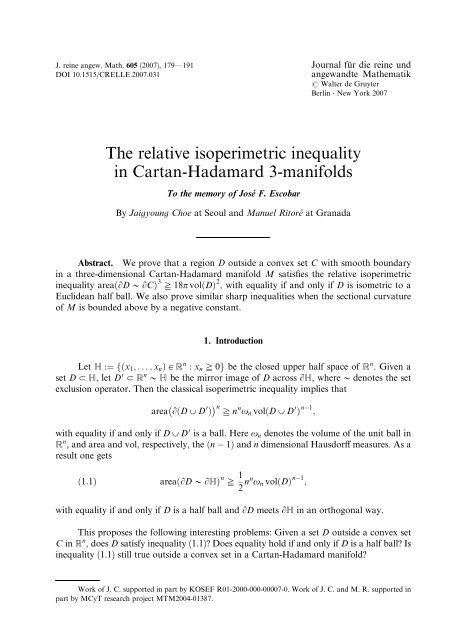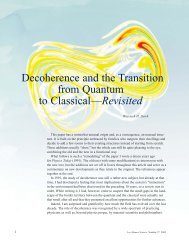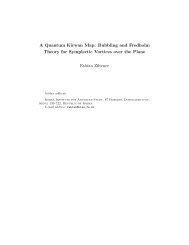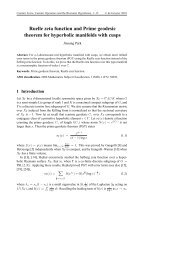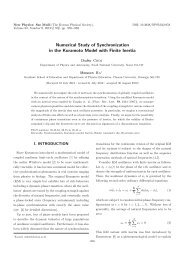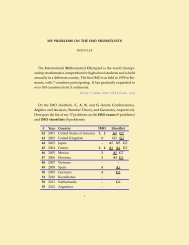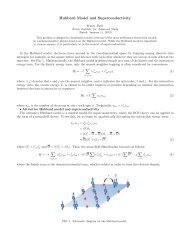The relative isoperimetric inequality in Cartan-Hadamard 3 ... - KIAS
The relative isoperimetric inequality in Cartan-Hadamard 3 ... - KIAS
The relative isoperimetric inequality in Cartan-Hadamard 3 ... - KIAS
You also want an ePaper? Increase the reach of your titles
YUMPU automatically turns print PDFs into web optimized ePapers that Google loves.
184 Choe and Ritoré, Relative <strong>isoperimetric</strong> <strong><strong>in</strong>equality</strong>HS 2 areaðSÞ f Ð H 2 dA f Ð Ðð3:7ÞdA b nðu b Þ ds:SS qSLet us see thatÐÐð3:8Þlim dA b ¼ lim e 2u bdA ¼ 2p:b!yS b!ySLet rð pÞ :¼ dð p; p 0 Þ be the extr<strong>in</strong>sic distance to p 0 . Fix r 0 > 0 small. Observe that e 2u b convergesuniformly to 0 <strong>in</strong> S out of the ball Bð p 0 ; r 0 Þ when b ! y. For r 0 small enough, themodulus of the gradient of rj S over S X Bð p 0 ; r 0 Þ is approximately 1, and the length ofS X qBð p 0 ; rÞ, for r A ð0; r 0 Þ, is approximately pr. By apply<strong>in</strong>g the coarea formula to rj Swe getÐSXBð p 0 ; r 0 Þ dA b ¼ p Ðr 02b 2r1 þ b 2 r 2 dr þ oðr 0 Þ¼2p þ oðr 0 Þ;where oðr 0 Þ converges to 0 when r 0 ! 0. Lett<strong>in</strong>g r 0 ! 0 we get (3.8).0On the other hand, qS is a curve (possibly disconnected) that bounds a regionR H qC. Recall that n, the <strong>in</strong>ner normal to qS on S, is also the outer normal to qC. Asp 0 A qC we see that a geodesic g p : ½0; t p Š!M from p 0 to any other po<strong>in</strong>t p A qS H qCmust satisfy g g 0 p ðt pÞ; nð pÞ f 0 by the convexity of C. Hence gð‘d; nÞ f 0 for all p A qSand we deduce thatnðu b Þ¼ 2b2 dgð‘d; nÞ1 þ b 2 d 2is a nonnegative function. Discard<strong>in</strong>g the last summand <strong>in</strong> (3.7) and tak<strong>in</strong>g limits we obta<strong>in</strong>(3.1).Let us consider now the equality caseð3:9ÞH 2 SareaðSÞ ¼2p:If (3.9) holds then there is also equality <strong>in</strong> (3.6), which implies thatð3:10aÞ ‘ 2 d 2 ðv; vÞ ¼2gðv; vÞ; for any p A S; v A T p S:We also have that limb!yÐqSnðu b Þ ds ¼ 0 s<strong>in</strong>ce, after tak<strong>in</strong>g limits, there is equality <strong>in</strong> (3.7).<strong>The</strong> sequence f nðu b Þg b is po<strong>in</strong>twise <strong>in</strong>creas<strong>in</strong>g and converges to 2nðdÞ=d. By the MonotoneConvergence <strong>The</strong>orem0 e Ð qS2nðdÞ Ðds ¼ limd b!yqSnðu b Þ ds ¼ 0;and soð3:10bÞgð‘d; nÞ 1 0along qS:
186 Choe and Ritoré, Relative <strong>isoperimetric</strong> <strong><strong>in</strong>equality</strong>where N is the unit normal to S <strong>in</strong> the direction of the mean curvature vector of S. Integrat<strong>in</strong>g(3.11) on S, we obta<strong>in</strong> the classical M<strong>in</strong>kowski formula3 volðWÞ ¼ 1 H areaðSÞ:This concludes the proof <strong>in</strong> the Euclidean case.Let us consider now the hyperbolic case. By scal<strong>in</strong>g the metric g of M we may assumethat k ¼ 1, so that the <strong><strong>in</strong>equality</strong> we <strong>in</strong>tend to prove isð3:12Þð 1 þ HS 2 Þ areaðSÞ f 2p;1Þ of constant sec-with equality if and only if W is a half-ball <strong>in</strong> the hyperbolic space M 3 ðtional curvature equal to 1.Consider aga<strong>in</strong> a po<strong>in</strong>t p 0 A qS and let d be the distance to p 0 . We def<strong>in</strong>e the family ofconformal metrics g b ¼ e 2u b g, given by the functionsð3:13Þu b ¼ logð12bb 2 Þþð1 þ b 2 ; b > 1:Þ coshðdÞWhen M is the three-dimensional hyperbolic space, this family of metrics is obta<strong>in</strong>edby homothetically expand<strong>in</strong>g the spherical metric! 21 tanh 2 ðd=2Þ1 þ tanh 2 g:ðd=2ÞFrom (3.2) we obta<strong>in</strong> the follow<strong>in</strong>g relation for the sectional curvatures of the tangentplane to S.e 2u bðK s Þ b¼ K s þ 1 þ e 2u b1 þ b 2 ð3:14Þþð1 b 2 Þþð1 þ b 2 Þ coshðdÞ P 2 ‘ 2 coshðdÞðe i ; e i Þ 2 coshðdÞ ;i¼1where fe 1 ; e 2 g is a g-orthonormal basis of the tangent plane to S. By the Hessian Comparison<strong>The</strong>orem we know that ‘ 2 coshðdÞ f coshðdÞg. So we obta<strong>in</strong>ð3:15Þe 2u bðK s Þ bf K s þ e 2u bþ 1:Equality holds <strong>in</strong> (3.15) if and only if ‘ 2 coshðdÞðe i ; e i Þ¼coshðdÞ for i ¼ 1; 2. From equation(3.3) and <strong><strong>in</strong>equality</strong> (3.15) we obta<strong>in</strong>Ð1 þ HSð 2 Þ dA f Ð ÐdA b nðu b Þ ds:S qSAs <strong>in</strong> the previous case one shows that lim dA b ! 2p and, by the convexity of C, thatb!yÐnðu b Þ f 0, which yields the desired estimate (3.12).S
Choe and Ritoré, Relative <strong>isoperimetric</strong> <strong><strong>in</strong>equality</strong>187If equality holds <strong>in</strong> (3.12) then we conclude, as <strong>in</strong> the Euclidean case, that‘ 2 coshðdÞðv; vÞ ¼coshðdÞ for any unit tangent vector v to S at any po<strong>in</strong>t of S, that H isconstant, and that gð‘d; nÞ ¼0 at any po<strong>in</strong>t of qS.Condition ‘ 2 coshðdÞðv; vÞ ¼coshðdÞ for any unit tangent vector v to S at any po<strong>in</strong>tof S implies, by the standard comparison theorems, that the metric g of W (i.e., on the coneover S with vertex p 0 ), has constant sectional curvatures equal to 1. Moreover, conditiongð‘d; nÞ ¼0 at any po<strong>in</strong>t of qS implies that R is a totally geodesic surface. F<strong>in</strong>ally, as S hasconstant mean curvature H > 1, we see as <strong>in</strong> [Mo], <strong>The</strong>orem 9, by tak<strong>in</strong>g <strong>in</strong>ner parallels,thatÐcoshðdÞþH s<strong>in</strong>hðdÞh‘d; Ni dA f 0; N ? SSwith equality if and only if W is a half ball <strong>in</strong> hyperbolic space. But s<strong>in</strong>ce the metric of W ishyperbolic, we have ‘ 2 coshðdÞ ¼coshðdÞg <strong>in</strong> W so that <strong>in</strong>tegrat<strong>in</strong>gon S we getD S coshðdÞ ¼2 coshðdÞþ2H s<strong>in</strong>hðdÞh‘d; NiÐScoshðdÞþH s<strong>in</strong>hðdÞh‘d; Ni dA ¼ 0:This completes the proof <strong>in</strong> the hyperbolic case k ¼ 1.F<strong>in</strong>ally, if S is merely C 1; 1 , the arguments <strong>in</strong> the proof apply without changes s<strong>in</strong>cethe pr<strong>in</strong>cipal curvatures of S, and hence the mean and the Gauss curvature, are def<strong>in</strong>ed almosteverywhere. <strong>The</strong> divergence theorem still holds under our weak hypothesis. rBy us<strong>in</strong>g the mean comparison result <strong>in</strong> Proposition 3.1 we can now prove the <strong>isoperimetric</strong>comparison theorem.<strong>The</strong>orem 3.2. Let M be a three-dimensional <strong>Cartan</strong>-<strong>Hadamard</strong> manifold with sectionalcurvatures bounded above by a nonpositive constant k, and let MðkÞ be the threedimensional<strong>Cartan</strong>-<strong>Hadamard</strong> manifold with constant sectional curvatures equal to k. Assumethat C H M is a proper convex doma<strong>in</strong> with smooth boundary and that H H MðkÞ isa half space. <strong>The</strong>n we haveð3:16ÞI C f I H ;which <strong>in</strong> turn implies that for any bounded f<strong>in</strong>ite perimeter set D H M C we haveð3:17ÞareaðqDÞ Cf I H volðDÞ :Moreover, equality holds <strong>in</strong> (3.17) if and only if D is isometric to a half ball <strong>in</strong> MðkÞ.Proof. S<strong>in</strong>ce the existence of <strong>isoperimetric</strong> regions is a crucial po<strong>in</strong>t of our arguments,but it is not guaranteed <strong>in</strong> the noncompact M C , we first construct an exhaustionof M C by <strong>relative</strong>ly compact sets fE k g k A N . We take p 0 A qC, and def<strong>in</strong>e E k ¼ Bð p 0 ; r k Þ C,where r k is an <strong>in</strong>creas<strong>in</strong>g diverg<strong>in</strong>g sequence of positive numbers, and Bð p 0 ; r k Þ is the closedball centered at p 0 of radius r k .
188 Choe and Ritoré, Relative <strong>isoperimetric</strong> <strong><strong>in</strong>equality</strong>S<strong>in</strong>ce E k is bounded, <strong>isoperimetric</strong> regions exist on E k for any given volumev A ð0; vol E k Þ. <strong>The</strong> boundary S of any <strong>isoperimetric</strong> region W <strong>in</strong> E k satisfies the regularityproperties of Lemma 2.1 provided there is no po<strong>in</strong>t <strong>in</strong> S X qC X ðqE k Þ C. Assume there isq 0 A S X qC X ðqE k Þ C. <strong>The</strong> set qE k is conta<strong>in</strong>ed <strong>in</strong> the geodesic sphere qBð p 0 ; r k Þ, whichmeets qC at q 0 at an angle less than or equal to p=2. Reflect<strong>in</strong>g locally W with respect toqC and blow<strong>in</strong>g up W and the metric from q 0 , [Gr1], we obta<strong>in</strong> a cone <strong>in</strong> R 3 which is aream<strong>in</strong>imiz<strong>in</strong>g <strong>in</strong> a wedge of R 3 . This implies regularity if the angle is p=2 and it is not possibleif the angle is less than p=2; see [G], Thm. 15.5.Fix k A N and assume that W k is an <strong>isoperimetric</strong> region <strong>in</strong> E k . <strong>The</strong> set W k may haveseveral components. Let W k ¼ W 1 k W W2 k , where W1 k consists of the components of W k touch<strong>in</strong>gqC (<strong>in</strong> an orthogonal way), and W 2 k consists of the components of W k disjo<strong>in</strong>t from qC.<strong>The</strong>n by (3.1)ðk þ H 2 ðqW 1 k Þ areaðqWCÞ 1 k Þ C f 2p½Kfcomponents of W1 kgŠ f 2p:On the other hand, by [Kl] or [R],ðk þ H 2 ðqW 2 k Þ areaðqWCÞ 2 k Þ C f 4p½Kfcomponents of W2 kgŠ f 0:Add<strong>in</strong>g both <strong>in</strong>equalities we getand henceðk þ H 2 ðqW k Þ CÞ areaðqW k Þ Cf 2p;ð3:18ÞH ðqWk Þ Cf H k areaðqW k Þ C;where H k ðaÞ denotes the mean curvature of a geodesic sphere of area 2a <strong>in</strong> MðkÞ. By Proposition3.1, equality holds <strong>in</strong> (3.18) if and only if W k is isometric to a geodesic half ball <strong>in</strong>MðkÞ.Denote by I k the <strong>isoperimetric</strong> profile of E k . By standard arguments, [Hs], pp. 170–172, we have I k is cont<strong>in</strong>uous and <strong>in</strong>creas<strong>in</strong>g, when I k is smooth at v 0 then I 0 k ðv 0Þ¼2H, where H is the constant mean curvature<strong>in</strong> the <strong>in</strong>terior of E k of any <strong>isoperimetric</strong> region of volume v 0 , and left and right derivatives of I k exist everywhere.S<strong>in</strong>ce I k is a cont<strong>in</strong>uous monotone function with left and right derivatives at every po<strong>in</strong>t, itis absolutely cont<strong>in</strong>uous.<strong>The</strong> cont<strong>in</strong>uity of I k follows from the convergence of <strong>isoperimetric</strong> regions. To provethe monotonicity of I k we just need to show that the constant mean curvature H of theboundary of an <strong>isoperimetric</strong> region W <strong>in</strong> the <strong>in</strong>terior of E k is positive. Let S ¼ qW C .IfSdoes not touch ðqE k Þ Cthen there is an outer parallel qC t to qC, which is tangent to S at
Choe and Ritoré, Relative <strong>isoperimetric</strong> <strong><strong>in</strong>equality</strong>189some po<strong>in</strong>t and leaves S on one side. Standard comparison theorems show that the pr<strong>in</strong>cipalcurvatures of qC t are nonnegative. By the maximum pr<strong>in</strong>ciple, H f 0. But <strong>in</strong> caseH ¼ 0, we obta<strong>in</strong> from the maximum pr<strong>in</strong>ciple that S and qC t locally co<strong>in</strong>cide and, by aconnectedness argument, that a connected component of S is conta<strong>in</strong>ed <strong>in</strong> qC t , which givesus a contradiction. If S X ðqE k Þ Cis not empty then the maximum pr<strong>in</strong>ciple shows that H islarger than or equal to the mean curvature of ðqE k Þ Cat some po<strong>in</strong>t, which is strictly positives<strong>in</strong>ce geodesic spheres <strong>in</strong> a <strong>Cartan</strong>-<strong>Hadamard</strong> manifold are strictly convex.<strong>The</strong> computation of the derivative I 0 k ðv 0Þ is standard by mak<strong>in</strong>g a variation supportedaround a po<strong>in</strong>t of S X <strong>in</strong>tðE k Þ. <strong>The</strong> fact that left and right derivatives always exist followsfrom the convergence of <strong>isoperimetric</strong> regions of volumes v k ! v 0 to an <strong>isoperimetric</strong> regionof volume v 0 , see [Hs], p. 171.Let J k be the restriction of the <strong>isoperimetric</strong> profile of MðkÞ to the <strong>in</strong>tervalð0; vol E k Þ. Let f ðaÞ, gðaÞ be the <strong>in</strong>verse functions of I k , J k , respectively. We know thatg 0 ðaÞ ¼Jk 0ðaÞ 1 ¼ 2H k ðaÞ 1, and that, when f0exists, f 0 ðaÞ ¼Ik 0ðaÞ 1 ¼ð2HÞ 1 , whereH is the mean curvature <strong>in</strong> the <strong>in</strong>terior of E k of any <strong>isoperimetric</strong> region of volume f ðaÞ.By Proposition 3.1, we obta<strong>in</strong> g 0 ðaÞ f f 0 ðaÞ a.e. S<strong>in</strong>ce f is absolutely cont<strong>in</strong>uous (and g issmooth), we have gðaÞ f f ðaÞ. It follows that I k f J k .If equality holds for some v 0 , then for a 0 ¼ J k ðv 0 Þ¼I k ðv 0 Þ we have gða 0 Þ¼ f ða 0 Þ.S<strong>in</strong>ce g 0 f f 0 we obta<strong>in</strong> that f 1 g <strong>in</strong> the <strong>in</strong>terval ð0; a 0 Þ and so H k ða 0 Þ 1 ¼ Hða 0 Þ 1 .IfW 0is any <strong>isoperimetric</strong> region of volume v 0 then Proposition 3.1 implies that W 0 is isometric toa half ball <strong>in</strong> MðkÞ of volume v 0 .F<strong>in</strong>ally let W H M C be <strong>relative</strong>ly compact with smooth boundary. <strong>The</strong>n W H E k forsome k, andPðWÞ f I k volðWÞ f I H volðWÞ :If equality holds then W is an <strong>isoperimetric</strong> region <strong>in</strong> E k and I k volðWÞ ¼ I H volðWÞ .Bythe discussion <strong>in</strong> the above paragraph we have that W is isometric to a half ball <strong>in</strong> MðkÞ ofvolume volðWÞ. rCorollary 3.3. Suppose that M is a three-dimensional <strong>Cartan</strong>-<strong>Hadamard</strong> manifold,C H M a proper convex doma<strong>in</strong> with smooth boundary, and D bounded and of f<strong>in</strong>ite perimeter<strong>in</strong> M @ C. <strong>The</strong>nareaðqD @ qCÞ 3 f 18p volðDÞ 2 ;and equality holds if and only if D is a flat half ball.4. <strong>The</strong> <strong>relative</strong> <strong>isoperimetric</strong> <strong><strong>in</strong>equality</strong> for a general convex setIn this section, C will denote a bounded strictly convex body <strong>in</strong> R 3 . No assumptionon the regularity of its boundary is made. We say that a convex body is strictly convex if itsboundary does not conta<strong>in</strong> a nontrivial segment [Sch], p. 77. Recall that p is an extremepo<strong>in</strong>t of C if it cannot be written <strong>in</strong> the form p ¼ lx þð1 lÞy, with x; y A C, x 3 y, and
190 Choe and Ritoré, Relative <strong>isoperimetric</strong> <strong><strong>in</strong>equality</strong>l A ð0; 1Þ. Any po<strong>in</strong>t <strong>in</strong> the boundary of a strictly convex set is an extreme po<strong>in</strong>t. A cap of Caround p is a set of the form C X H þ , where H þ is a closed half space with p A <strong>in</strong>t H þ ,[Sch], pp. 18–19.For strictly convex sets we have the follow<strong>in</strong>g result:<strong>The</strong>orem 4.1. Let C H R 3 be a proper convex doma<strong>in</strong> which is strictly convex, andH H R 3 a half space. <strong>The</strong>n, for any v > 0,I C ðvÞ > I H ðvÞ:That is, equality never holds <strong>in</strong> the above <strong><strong>in</strong>equality</strong> for these convex bodies.Proof. Us<strong>in</strong>g standard results on the Hausdor¤ metric, we can f<strong>in</strong>d a sequenceof convex bodies with smooth boundary C k H R 3 , with C H C k for all n A N, converg<strong>in</strong>g<strong>in</strong> the Hausdor¤ distance to C. Let W H ðR 3 Þ Cbe a <strong>relative</strong>ly compact set and def<strong>in</strong>eW k ¼ W X ðR 3 Þ Ck. <strong>The</strong>n volðW k Þ!volðWÞ and P C ðWÞ f P Ck ðW k Þ. S<strong>in</strong>ce the <strong>relative</strong> <strong>isoperimetric</strong><strong><strong>in</strong>equality</strong> (2.1) is satisfied <strong>in</strong> ðR 3 Þ Ck, we have P C ðWÞ f P Ck ðW k Þ f I H volðW k Þ .Tak<strong>in</strong>g limits, we get P C ðWÞ f I H volðWÞ , and the <strong>isoperimetric</strong> <strong><strong>in</strong>equality</strong> I C ðvÞ f I H ðvÞholds <strong>in</strong> ðR 3 Þ C.To see that this <strong><strong>in</strong>equality</strong> is always strict, consider a region W H ðR 3 Þ Csuchthat equality P C ðWÞ ¼I H volðWÞ holds. Let p be a po<strong>in</strong>t <strong>in</strong> the <strong>in</strong>terior, <strong>relative</strong> to qC,of qW X qC. <strong>The</strong> strict convexity implies that p is an extreme po<strong>in</strong>t of C. By [Sch], Lemma1.4.6, there is a cap P þ of C around p conta<strong>in</strong>ed <strong>in</strong> the <strong>in</strong>terior of qW X qC. Let P bethe half space obta<strong>in</strong>ed as the closure of the complement of the half space determ<strong>in</strong><strong>in</strong>gP þ . Consider the convex set C 0 ¼ C X P , and W 0 ¼ W W ðC X P þ Þ. We haveP C 0ðW 0 Þ¼P C ðWÞ, and volðWÞ < volðW 0 Þ. HenceP C 0ðW 0 Þ¼P C ðWÞ ¼I H volðWÞ < I H volðW 0 Þ ;and so I C volðW 0 Þ < I H volðW 0 Þ . This is a contradiction, s<strong>in</strong>ce we have already provedthat <strong>in</strong> ðR 3 Þ C0 the <strong>isoperimetric</strong> <strong><strong>in</strong>equality</strong> I C ðvÞ f I H ðvÞ holds. rRemark 4.2. <strong>The</strong> first paragraph <strong>in</strong> the proof of <strong>The</strong>orem 4.1 shows that the <strong>isoperimetric</strong><strong><strong>in</strong>equality</strong> areaðqD @ qCÞ 3 f 18p volðDÞ 2 holds for any region D outside a convexset C with nonsmooth boundary <strong>in</strong> R 3 . <strong>The</strong> authors have not characterized what happens<strong>in</strong> the equality case, and they believe that techniques di¤erent from the ones used <strong>in</strong> thispaper should be employed.References[A] T. Aub<strong>in</strong>, Problèmes isopérimétriques et espaces de Sobolev, J. Di¤. Geom. 11 (1976), 573–598.[BG] E. Bombieri and E. Giusti, Harnack’s <strong><strong>in</strong>equality</strong> for elliptic di¤erential equations on m<strong>in</strong>imal surfaces,Invent. Math. 15 (1972), 24–46.[BZ] Y. D. Burago and V. A. Zalgaller, Geometric <strong>in</strong>equalities, Spr<strong>in</strong>ger, Berl<strong>in</strong> 1988.[C1] J. Choe, Relative <strong>isoperimetric</strong> <strong><strong>in</strong>equality</strong> for doma<strong>in</strong>s outside a convex set, Arch. Inequ. Appl. 1 (2003),241–250.
Choe and Ritoré, Relative <strong>isoperimetric</strong> <strong><strong>in</strong>equality</strong>191[C2] J. Choe, <strong>The</strong> double cover <strong>relative</strong> to a convex set and the <strong>relative</strong> <strong>isoperimetric</strong> <strong><strong>in</strong>equality</strong>, J. Aust. Math.Soc. 80 (2006), 375–382.[Cr] C. Croke, A sharp four dimensional <strong>isoperimetric</strong> <strong><strong>in</strong>equality</strong>, Comment. Math. Helv. 59 (1984), 187–192.[G] E. Giusti, M<strong>in</strong>imal surfaces and functions of bounded variation, Monogr. Math. 80, Birkhäuser Verlag,Basel-Boston 1984.[GMT] E. Gonzalez, U. Massari and I. Taman<strong>in</strong>i, On the regularity of boundaries of sets m<strong>in</strong>imiz<strong>in</strong>g perimeterwith a volume constra<strong>in</strong>t, Indiana Univ. Math. J. 32 (1983), 25–37.[GLP] M. Gromov, J. Lafonta<strong>in</strong>e and P. Pansu, Structures métriques pour les variétés Riemanniennes, Cedic/Fernand Nathan, Paris 1981.[Gr1] M. Grüter, Optimal regularity for codimension one m<strong>in</strong>imal surfaces with a free boundary, Manuscr.Math. 58 (1987), 295–343.[Gr2] M. Grüter, Boundary regularity for solutions of a partition<strong>in</strong>g problem, Arch. Rat. Mech. Anal. 97(1987), 261–270.[Hs] Wu-Yi Hsiang, On soap bubbles and <strong>isoperimetric</strong> regions <strong>in</strong> noncompact symmetric spaces, I, TohokuMath. J. (2) 44 (1992), no. 2, 151–175.[K] I. Kim, An optimal <strong>relative</strong> <strong>isoperimetric</strong> <strong><strong>in</strong>equality</strong> <strong>in</strong> concave cyl<strong>in</strong>drical doma<strong>in</strong>s <strong>in</strong> R n , J. Inequ. Appl.1 (2000), 97–102.[Kl] B. Kle<strong>in</strong>er, An <strong>isoperimetric</strong> comparison theorem, Invent. Math. 108 (1992), 37–47.[LY] P. Li and S. T. Yau, A new conformal <strong>in</strong>variant and its applications to the Willmore conjecture and thefirst eigenvalue of compact surfaces, Invent. Math. 69 (1982), 269–291.[Mo] S. Montiel, Unicity of constant mean curvature hypersurfaces <strong>in</strong> some Riemannian manifolds, IndianaUniv. Math. J. 48 (1999), 711–748.[MoR] S. Montiel and A. Ros, Compact hypersurfaces: the Alexandrov theorem for higher order mean curvatures,Di¤erential geometry, Longman Sci. Tech., Harlow (1991), 279–296.[R] M. Ritoré, Optimal <strong>isoperimetric</strong> <strong>in</strong>equalities for three-dimensional <strong>Cartan</strong>-<strong>Hadamard</strong> manifolds, Globaltheory of m<strong>in</strong>imal surfaces, Clay Math. Proc. 2 (2005), 395–404.[Sch] R. Schneider, Convex bodies: the Brunn-M<strong>in</strong>kowski theory, Cambridge Univ. Press, Cambridge 1993.[StZ] E. Stredul<strong>in</strong>sky and W. P. Ziemer, Area m<strong>in</strong>imiz<strong>in</strong>g sets subject to a volume constra<strong>in</strong>t <strong>in</strong> a convex set, J.Geom. Anal. 7 (1997), 653–677.[Wh] B. White, Existence of smooth embedded surfaces of prescribed genus that m<strong>in</strong>imize parametric evenelliptic functionals on 3-manifolds, J. Di¤. Geom. 33 (1991), 413–443.Korea Institute for Advanced Study, 207-43 Cheongryangri 2-dong, Dongdaemun-gu,Seoul 130-722, South-Koreae-mail: choe@kias.re.krDepartamento de Geometría y Topología, Facultad de Ciencias, Universidad de Granada,18071 Granada, Españae-mail: ritore@ugr.esE<strong>in</strong>gegangen 16. Juli 2004, <strong>in</strong> revidierter Fassung 16. Februar 2006


